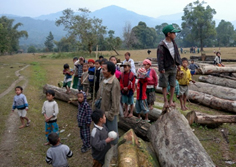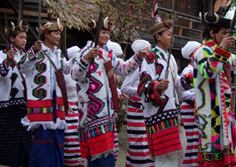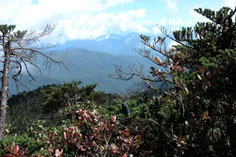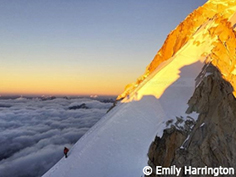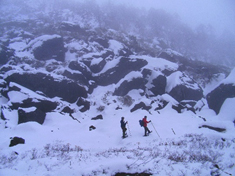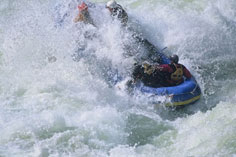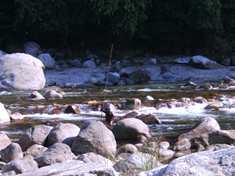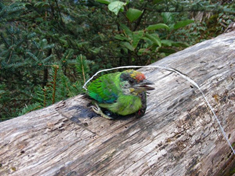Village Trekking, Peak Trekking, Special Interest tours and Expeditions

Expeditions & Alpine Climbing
View some of the research Expeditions, Snowshoing, Winter Wilderness, Alpine Climbing and expeditions to the highest peaks of South East Asia.

Village Trekking
See our village trekking in Putao Valley and Machanbaw Valley. These easy to moderate walking holidays also make a great cultural and indigenous tours.

Special Interest Activities
Our special interests activities ranges from bird watching, flaura and fuana expeditions to fishing Safaris in Myanmar Himalayan outback.

Mountain and Peak Trekking
We outfit mountain trekkings to Myanmar Himalayan peaks outside Monsoon season including Phongun, Phon Yin, Phangran and MaDoi Razi.

Hkakabo Razi National Park Discovery Expeditions
Our Hkakabo Razi National Park Discovery Expeditions are a great and unique way to experience the rich cultural heritage of its indegenous people and its incredible biodiversity.

Featured Activity - White Water Rafting
The exclusive wilderness journey on the western headwater of Ayeyarwaddy River combines the trill of Class 3 and 4 white water rafting and the insight into the way of life of indigenous people unchanged for centuries.
Lisu Trail
Trekking adventure with overnight stay at Putao Trekking House
(4night 5day trek, Moderate)
Rawang Trail
Trekking adventure with overnight stay at Putao Trekking House
(3night 4day trek, Easy)
Rawang Explorer
Trekking adventure with overnight stay at Malikha Lodge
(7night 8day trek, Easy to Moderate)
Little Tibet, Zalathu Cattle Stations and Diphuk-Ha Pass
(28night 29day trek, Challenging to Tough)
Hkakabo Razi National Park Explorer
(24night 25day trek, Challenging to Tough)
(The last village trekking to Dahaungdum)
Nam Lang River Expedition
White water rafting expedition with overnight stay at Malikha Lodge
(4night 5day trekking and rafting, Easy to Moderate Trek, Challenging Raft)
View Details >
Dungawnmai Flora & Fauna Expedition
30night 31day trek, Challenging to Tough)
View Details >
Fishing safaris
MaDoi and Namplat Creek
View Details >
Garhtu and Kasan Creek
View Details >
Village Trekking |
|||
| Tours | Duration | Grade | Best time |
| Putao Valley Village Trekking | 5 Days | Easy | October to May |
| Lisu Trail (O/N at Putao Trekking House) | 5 Days | Easy | October to May |
| Rawang Trail (O/N at Putao Trekking House) | 5 Days | Easy | October to May |
| Myanmar Himalayas Indigenous Trail | 6 Days | Easy to Moderate | October to May |
| Rawang Explorer (O/N at Malikha Lodge) | 8 Days | Moderate | October to May |
| O/N: overnight stayOur trekking trips comes with overnight accommodation at guesthouses and village homes unless otherwise stated. | |||
Mountain Trekking |
|||
| Tour | Duration | Grade | Best time |
| Phongan Razi Expedition | 12 Days | Demanding | October to May |
| Phon Yin Razi Expedition | 12 Days | Demanding | October to May |
| MaDoi Razi Expedition | 15 Days | Extremely Demanding | October to May |
| Phangran Razi Expedition | 15 Days | Extremely Demanding | October to May |
Hkakabo Razi Explorer |
|||
| Tour | Duration | Grade | Best time |
| Little Tibet - Zalathu and Diphuk-Ha pass | 29 Days | Extremely Demanding | October to May |
| Hkakabo Razi National Park Explorer | 25 Days | Extremely Demanding | October to May |
| Hkakabo Razi Basecamp | 36 Days | Extremely Demanding | October to May |
| Dungawnmai Flaura and Fauna Expedition | 31 Days | Expedition Grade @most difficult! | August to May |
Expeditions and Alpine Climbing |
|||
| Tour | Duration | Grade | Best time |
| The Hkakabo Razi Expedition | 50 Days | Expedition Grade plus | August to May |
| The Gamlang Razi Expedition | 46 Days | Expedition Grade | August to May |
| Research Expeditions | Tailor Made | Moderate to extremely demanding | August to May |
| Snowshoeing Expeditions | Tailor Made | Demanding to extremely demanding | August to May |
Special Interest Tours |
|||
| Tour | Duration | Grade | Best time |
| Nam Lang River Expedition | 5 Days | Easy to Moderate | November to March |
| Dungawnmai Flora and Fauna Expedition | 31 Days | Demanding | October to May |
| MaDoi and Namplat Creek Fishing Safari | 15 Days | Moderate to Demanding | October to May |
| Garhtu and Kasan Creek Fishing Safari | 11 Days | Moderate to Demanding | October to May |
About Myanmar Himalayas
Myanmar Himalaya Mountains are situated in the northern most part of Kachin State of the Union of Myanmar, bordered to India and the Tibetan Highlands of China.
The Himalaya (Abode of Snow, in Sanskrit) is the highest mountain range on earth run along Pakistan, several northern Indian states, the Kingdom of Nepal, Bhutan and Tibetan Highland and Myanmar. Myanmar Himalaya is the lower mountain range of southern Himalaya.
Myanmar Himalaya is the perfect place for trekking and adventure tours for those who want to explore the off the beaten treks. Hkakabo Razi Mountain in Myanmar Himalaya is the highest peak in South East Asia. Its peak was never been measured, but its height was estimated to be more than 5900 metres with permanent snow field all year round above the snow line. There are only 4 teams of climbers attempted to scale this mighty peak. The first ascent was made by Takashi Ozaki (Japan, 1951-May 14, 2011) and Nyima Gyaltsen (Myanmar). All Myanmar Climbers team attempted the ascent in August 2014, all Japanese climbers team in September 2014 and all American team in October 2014. The Myanmar Climb Expedition to Hkakabo Razi Mountain by all American team consists of National Geographic and The North Face explorers was outfitted by us, Myanmar City Star Travel & Tours. Its nearby peak of Gamlang Razi was considered as the country’s second highest peak. An American Myanmar friendship team led by Andy Tyson made the first ascent of Gamlang Razi and measured at 5,870 meters (19,259 ft) using an advanced version of GPS.
Putao (pronounced Bu Tao) is the gateway to the Myanmar Himalaya Mountains. Most Myanmar Himalaya mountains including Phon Gan Razi (one of the lowest range and the easiest mountains to get to) are very well blessed with heavy snow fall in the winter time usually from November till April or May.
There are plenty of activities you could do in Myanmar Himalaya region: such as village trekking, mountain trekking, mountain biking, white water rafting and snow shoeing.
Myanmar Himalaya travels not only gives you a truly wonderful experience and a completely different sights and scenes from the mainland Myanmar but also gives you the opportunities and experience to meet the shy yet strong spirited local indigenous populations including Hkamti Shan, Rawang, Lisu, Tibet, their rich cultural heritage and ways of living. Your Myanmar Himalaya travel is also a mean of contributing the local community who work as the most essential supporting crew on all our expeditions (mountain guides, trail leaders, cooks, porters, hosts of village homestays) and their economy.
Myanmar Himalaya travels not only gives you a truly wonderful experience and a completely different sights and scenes from the mainland Myanmar but also gives you the opportunities and experience to meet the shy yet strong spirited local indigenous populations including Hkamti Shan, Rawang, Lisu, Tibet, their rich cultural heritage and ways of living. Your Myanmar Himalaya travel is also a mean of contributing the local community who work as the most essential supporting crew on all our expeditions (mountain guides, trail leaders, cooks, porters, hosts of village homestays) and their economy.
Putao, the gateway to Myanmar Himalayas
Putao is the start point of all our Myanmar Himalayas tours. There is a small market that sell vegetable, groceries, other local produces, inexpensive woollen hats, fleeces and canvas boots imported from China. Although vegetable stalls are operated only in the morning, some shops that sell groceries, other consumable and local produce open throughout the day. Things can be a little more expensive in Putao than in mainland Myanmar as they are either carried on the plane from the mainland, long overland car journey outside the wet season or via long trekking trips from Chinese borders.
Domestic flights
Flights operate between Putao and Yangon via Mandalay and Myitkyinar on Tuesdays, Fridays and Sundays. All our itineraries are tailor to arrive and depart Putao on these days. Travellers have the option of flying from or to Yangon, Mandalay and Myitkyinar.
Weather
The best season to travel in Putao area is between October and May of the year. Although there may still be some wet days in October, the skies are mostly clear during the rest of the season with warm day time temperature, cool morning and evening. December to February is coolest month of the year and the average temperature is 4 to 10 °C minimum and 22 to 30 °C maximum. Temperature is much lower in higher altitude and snow-capped frozen peaks.
Zone entry permission
At the moment independent traveling is restricted beyond and outside of Putao town. All travellers require at least the zone entry permission from MTT (permissions from the Ministry of Forestry and Wildlife may also be required on certain routes) and the accompany of a licensed tour guide preferably specialised in Putao area. Therefore travellers are require to get tailor made services or package tours to the area from specialised local tour operators or indirectly via Myanmar base or international operators who use local operator partners. All our tours in Putao area include all required permissions.
Travel insurance
All travellers are responsible to take out a suitable travel insurance that will cover the travel to this particular remote area, trip cancellation, baggage protection and the activities they are pursuing, in some cases travellers may require an insurance that also cover search and rescue with helicopter evacuation and emergency medical cover.
Emergency contacts & next of kin
We obtain the emergency contacts and next of kin of all our customers at the time of booking. So that we can contact them if needed. We advise clients to give our contact to their next of kin. We also encourage to inform their country embassies in Myanmar prior to their Myanmar Himalaya tours.
Health & safety
Health Care facilities are very much limited in Putao area. The essential medical care is almost non-existence in Hkakabo Razi National Park. Therefore we advised you to take care of your own health and general safety. You should bring in your personal first aid kits, general medicines to relieve minor illness, your usual medications and other medicine and equipment depending on your activities and the level of risk involved. We also encourage clients to bring in extra medicine to donate to the villages along their way if they wishes. Drink bottled purified water, boiled or treated water. Avoid eating raw vegetable. Wash fruits thoroughly before consumption and eat fruits which you peel or cut yourself. Sunscreen should be used to protect your skin from intense tropical sun. Insect repellents should be used to protect from mosquitoes and sand flies. Sand flies are common when traveling near water sources, stream, creeks and rivers.
Accommodation
Depending on the tour package and services you took from us, you will have different accommodation options. There are three groups of activities that come with different accommodation options, Putao Lodge Hotel, Malikha Lodge Resort and a combination of guesthouses and homestays. We highlight the accommodation options in our itineraries. Putao Lodge Hotel and Malikha Lodge Resort comes with a standard facility such as private bath with hot and cold shower/ bath and western toilets. Guesthouses and Village homestay accommodation come with limited supplies of hot water for face wash in the morning or evening. Toilets are mostly clean but local squat style and usually located outside the house. At village homes, host usually provide a room (usually a front room with fireplace in the middle) where all guests will sleep on the floor on a dormitory style. Hotels, guesthouses and camping tents are on twin share basis. Clients can request for single rooms and tent for single occupancy at extra costs (single supplement).
Communication
Putao has mobile network facility and you can connect with the world from within the town. Once you leave Putao, the communication become limited except for occasional radio phone facility at some village. For specialised and longer expeditions with much higher risks in Myanmar Himalayas, our past clients bring Satellite phones with the required permissions from the Federal Government, Customs and Authorities, and also SatSleeves and satellite modem. Although the connection is not always guaranteed, you can still connect with the word from wilderness.
Electricity
Electricity is available for a limited number of hours a day in Putao, sometime it may not be available every day. The current is 200V/ 50Hz and sockets have two round or flat pins. We recommend to bring a world travel mains adaptor charger plug, head lamps, reading lights and torches.
Meal
We provide breakfast, lunch and dinner during your trekking and expeditions. Breakfast is served hot in the morning, light lunch is served around mid-day and dinner is served is the main meal of the day. Clients are required to notify any special dietary requirements and preferences at the time of booking.
Baggage
As the rule of thumb, travellers need to keep personal items to minimum when packing for wilderness expeditions. Our baggage weight allowance is 15-20 Kilograms (33-44 pounds) per person including clothing and personal equipment. For specialised expeditions where clients need to bring extra equipment and items, we can arrange more porters at an extra costs. Our porters use funnel shaped basket to carry client’s baggage. Therefore please avoid rigid frame suitcases, but use a medium size duffle bags. Or your large frame suitcases needs to be left in Putao. Your day pack should be big enough to store your valuables, water, medications, camera, sunscreen, spare socks etc. During your trekking and expeditions, non-essential items and some valuables could be put in a lockable luggage and stored in our operator’s office in Putao.
Other personal items
Personal first aid kits, headlamp, torch lights, spare batteries, water purifying tablets, pocket knife, notebook, pen and books to read are highly recommended.
Camping equipment
We provide camping tents and mats on trekking expeditions. Sleeping bags are provided on wilderness expeditions with Malikha Lodge stay. For all other expeditions you will have to bring your own sleeping bags. We recommend to use a 4 Season sleeping bags. For specialised expeditions in extreme weather conditions, clients may want to bring their own specialised expedition tents. Some village homes provide mattresses, pillow and blankets.
Clothing
We recommend to bring lightweight and quick drying clothes which also provide insulation. You should bring base layer, mid layer (fleece/ sweater) and waterproof and windproof outer jackets. Temperature decline considerably in the evening and in early morning and you will need to keep warm. Waterproof pants, gaiters and gloves are also highly recommended for longer treks and higher altitude treks.
Footwear
Bring at least 3-5 pairs of good quality trekking socks, and warmer ones if you are trekking to a higher altitude and snow-capped peaks. For lower trek, lightweight hiking boots that protects your toes and ankles are highly recommended. For longer trek, you must bring a good quality, study, preferably lightweight and protective hiking boots that will stand the journey. You may also want to bring an extra pair of lightweight hiking boots just in case.
River wear
We recommend clients to bring durable and quick drying Patagonia shorts and baggies or other equivalent technical clothing on the river, good quality splash pants and jackets to keep you warm and dry, baseball style cap and polarized sunglasses with retainer strap to keep them on your face. Wet suits are required for rafting in coldest months from December to February of the year to protect against the cold and potential heat loss and the bathing suit to wear under the wet suit. As a standard safety requirements, all rafters must bring the footwear they can wear in the raft which will not come off in the event of a swim.
Transportation
The number of motor vehicles available in Putao are limited. In order to optimise the limited resources, many clients may share one vehicle.
Unforeseen circumstance
Weather in mountainous regions are not always good, which may results in flight delays. Clients should allow for the delays and cancellations when planning their onward journey. For example, not to connect to an international flight to depart on the same day as your Putao – Yangon/ Mandalay flight. During the monsoon, the water level in the creek go up really high in Myanmar Himalayas. After the water level goes down in post monsoon, some of the trails are being destroyed, therefore sometimes it takes longer to go on the same trail or finding alternative route to proceed the journey. In some cases, you may need to walk longer on some of the days, shorten the journey or take extra days. Therefore clients should keep in mind that all itineraries are for examples only and the actual routes may varies depending on the local circumstances.
Guides, tour leaders, trail leaders and local supporting crew
All our tours are supported by local crew (mountain guides, trail leaders, cooks and porters) who are native to Putao, its surrounding villages and Hkakabo Razi National Park. We provide a licensed English language tour guide as your tour leader who may or may not be able to speak local indigenous dialects. We may include additional trail leaders who are able to speak local indigenous dialects, who will help the guide with translation and communications with the local communities during the expeditions. The tour guide will then able to translate and explain things to you accordingly. In specialised and long expeditions, we will provide at minimum two English speaking staff for a group size bigger than 4 participants.
Tipping
Tipping to the local supporting crew such as tour leaders, trail leaders, cooks and porters for a job well done on the tour is a common practice. Some of our guests also throw a small party with the crew at the end of the tour to celebrate the success of their trip and mission accomplished. For hotel staff, there is usually a tipping box in the lobby which is equally distributed among all members of the team who all work towards making your stay pleasant.
Fitness
Clients need to carefully assess themselves and ensure that they are fit enough to participate in their chosen tour activities.
Grading system
Except for specialised expeditions by professional mountaineers, the rest of our programs do not require technical mountaineering/ rafting skills or previous experience. During your expedition, you will be under the direction of your tour leader who has the authority to determine your suitability to participate.
Trekking Grades
Easy
Previous walking or trekking experience is not necessary. Suitable for anyone who is in good health and fit enough to complete a weekend walk. Walks will be predominantly on good path, flat terrains and low altitudes but may involve a reasonable amount of ascent and descent. Trips within this grade involves half to full day easy paced walking for a duration of less than 5 days.
Moderate
Previous walking or trekking experience is not necessary. Suitable for individuals who are active, in a good health and reasonable fitness. Recommended for those who enjoys hill walks. General condition of the trails will be fair, however it may involve walks and treks on some higher altitude treks in mountains or more remote parts of Myanmar Himalaya with demanding ascents and descents. Trips in this grades involves usually 5 to 6 hours a day for a period of 5 to 10 days walking or trekking, occasional longer or harder days may be involved.
Challenging (demanding)
Previous walking or trekking experience is desirable, however not vital if participants are confident about their level of their fitness, health and physical conditions. Suitable for individuals with good level of fitness and health. Recommended for enthusiastic hill and mountain walkers. Trails are more challenging and may include mountainous terrains at higher altitudes, remote wilderness, high passes above snowline, some difficult terrains, demanding ascents and descents. Trips within these grades usually involves 6 to 8 hours trek days over a period of two to three weeks, occasionally longer or harder days may be involved depending on the altitude, climate, remoteness as well as the fitness level of the participants.
Tough (extremely demanding)
Previous regular experience of trekking preferably at altitudes and ability to trek for several days over difficult terrain is highly recommended. Suitable for confident and experienced trekkers with very good level of fitness, stamina and health. Trails are much more challenging and may include long period of time at higher altitudes often in the remote wilderness far from civilisation, difficult and technical terrains, demanding and steep ascents and descents. Trips within this grade may involve anything from 2 to 5 weeks on trek, 6 to 9 hours trekking a day which could be longer on occasional days depending on the altitude, climate, remoteness as well as the fitness level of the participants.
Expedition Grade
Previous experience of hard long treks for several days on difficult terrains in high altitude mountain environments is required. Suitable for confident and experienced trekkers with very good level of fitness, stamina and health. Some technical experience including the use of ice axe, crampons and safety ropes is required. Highly recommended for those with regular experience of expeditions, professional athletes and mountaineers. Trails are much more challenging and may include long period of time at higher altitudes, overnight camping above the snow line, difficult and technical terrains, demanding and steep ascents and descents. Trips within these grades usually involved 6 to 9 hours trekking a day over a period of anything over 3 to 6 weeks or more. They usually involves consecutive longer and harder days in very remote wilderness far from civilisation and may factors are dependent upon altitude, climate, trail conditions that changes every year as well as the stamina and fitness level of participants.
Rafting Grades
Grade 2+ (Easy)
Rafting within this grade usually involves gentle water with occasional rapids which clients can enjoy sites and sound while team paddle the raft.
Grade 3-4 (Demanding)
Rafting within this grade usually involves more adventure in the white water with multiple rapids where everyone has to take part as a team to manoeuvre the raft.
Camping
- Sleeping bags are provided on Rawang Explorer and The Nam Lang River Expedition only
- For the rest of the tours, clients need to bring their own sleeping bag (at least a three season bag, either down or synthetic filled) and a lining if you use one
- Therma-rest (inflatable sleeping mattress)
Luggage
- A frameless back pack or medium duffle bag (recommended luggage size: maximum 45L)
- A day bag (light backpack) to keep your valuables, drinking water, camera, medicine, etc.
Personal clothing
- Clothing should be lightweight, dry quickly, and provide insulation even when wet
- Long sleeved Thermal top and bottom (long underwear), synthetic clothing which maintain the insulation even when wet. We recommend zippered polar neck, as it can be vented when warm and also protect your neck from sun
- Cotton underwear
- Cotton t-shirts
- Light weight long sleeved shirts
- Good trekking socks that dry fast
- A fleece jacket
- Light weight Jacket and trousers, preferably made of windproof materials
- A Gore-Tex or similar material raincoat and trousers
- Wind & water resistant gloves
- Waterproof trousers, leg gaiters, additional socks the thermal hats and gloves are highly recommended for longer treks and higher altitude treks
- A baseball style cap
- Good pairs of polarized sunglass with cord or chain
Miscellaneous personal items
- Spare passport photos
- The usual personal toiletries (keep it to a minimum)
- Light weight, micro towel
- Spare glasses or contact lenses
- A good first aid kit
- Sewing kit
- Headlamp
- Anti-bacterial wipes or hand wash gels
- Laundry soap
- Insect Repellent (especially against mosquitoes and sand flies)
- Lightweight cotton gloves (which may be used as additional insect protection)
- Sun screen with SPF 15 minimum (sand and water proof)
- Lip balms with SPF 15 minimum
- Water bottle
- Spare shoe laces
- Trekking
- Day bag
- Lightweight supportive good hiking boots (preferably already worn in)
Optional items to bring
- Camera and film (good cleaning kits, spare batteries & water & dust resistant cases are recommended)
- Small binoculars with a waterproof case
- Pocketknife or Swiss army knife
- Fishing equipment
- Reading and writing material
- Personal first aid kit
- Personal linen, pillow case or under sheet
- Swimming costume or swimming shorts
- A sarong for women
Equipment for special expeditions
Clients should bring their own specialised equipment for alpine and other technical climbing expeditions.We provide the following
for all clients on our rafting and trekking expeditions:- Accommodation at local house or in tents
- Tent
- Cooking equipment including all kitchen utensils, pots, pans, plates and cups
- Toilet paper and lighter (we recommend you burn the toilet paper after using it)





